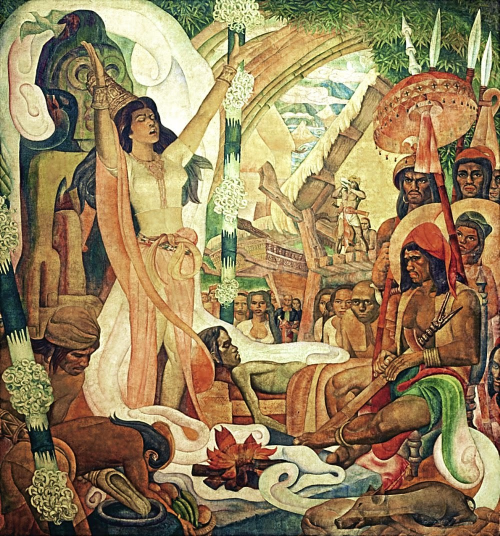The Artist Abroad

Babaylan, Ang Manggagamot.’ Detail of mural “History of Philippine Medicine” by Carlos “Botong” Francisco. FROM XiaoChua.net
Part II: In the Name of the Mother
New York—Not too long ago, the idea of a priestess in the Roman Catholic Church would have been deemed too far out, completely out of sync with the institution’s centuries-old dominant patriarchy.
It may still seem that way but given the tenor of the times and the increasing responsibilities of women that go beyond traditional roles in contemporary society, it no longer is a question of if but of when.
In this regard something so ancient will invariably be regarded as new.
Pagan religions, for instance, gave way more space to female power brokers than Christianity did. In Sumer and Akkadia, there were priestesses whose status was equal to that of the high priests and who had considerable autonomy, owning property, conducting business, and able to officiate at ceremonies that involved priests and the kings.
Then there was God’s Wife of Amun, the highest ranking priestess of the cult of Amun, a central religious group in ancient Egypt. She had tremendous power in both the religious and political spheres, as the two were intertwined. (In the 21st century, no one will deny that the Pope, heading an institution with more than a billion members, does wield considerable influence in civil society.)
The Suprema of Banahaw in her universe was in a similar position. It was evident that the town officials and the heads of the barrios that made up the nearby towns of Santa Lucia and Kinabuhayan (meaning “Resurrection”) at the very least considered and often solicited her views before enacting any policies affecting their constituents.
Olive-skinned, serene, and regal, she looked like a Mayan princess. Speaking in beautiful and courtly Tagalog, she enlightened us concerning the Ciudad’s beliefs. Its followers believe in God the Father, God the Mother, God the Holy Spirit, and Jesus Christ.
They celebrate the Roman Catholic Mass, with official celebrants who could be male or female. However, since they do not observe the Sacrament of the Eucharist, the belief being that a person can communicate directly with the Divine, their Mass omits the ritual of giving communion to the congregation.
The chapel in which the Mass had just been said had a Dali-esque altar: Wings flank a painted crown of thorns that runs horizontally the altar’s length. At the center is a large triangle, the all-seeing divine eye in its midst.
Murals around the chapel tend toward the apocalyptic and the feminist, emphasizing the role of women in saving the world . A central portrait is the Babae-Lalaki (Woman-Man), a Joan-of-Arc-like figure that combines yin and yang and symbolizes transcendence over earthly form. This nonsexist notion of the Divine Principle, referred to as Bathala—akin to the idea of the Divine contained in the Gnostic texts but viewed as heretical by the Vatican—is one that the Spanish friars and American missionaries would have found disturbing.
And the origin story predating the arrival of the sword and the cross has the First Man, Malakas (Strength) and the First Woman Maganda (Beauty) springing forth from bamboo at the same time and as equals. No need, as the Judeo-Christian Bible has it, for a rib to be taken from man in order to create woman.
But the murals also pay homage to José Rizal, the national hero. I wondered aloud as to why, as I understood that in their divine cosmology there were no saints.
The Suprema replied, “We respect Rizal as a sublime hero, one embraced by God.” Echoing what the Spanish philosopher Miguel de Unamuno had said about Rizal, she added, “Rizal may be the Christ of the Tagalogs.”
Rizal then was no mere saint, but a divine avatar, a reincarnation of the Christ—a belief common among the members of the various Banahaw cults, especially given that Rizal’s last words before he was executed by a firing squad in 1896 were those of Christ on the cross: Consummatum est, or It is finished.
I asked the Suprema why the chapel had crosses but no crucifixes. The reason she gave resembles Islam’s interdiction: “We do not use portraits as God forbids it. No one knows God’s true visage.”
The Ciudad Mistica is a cooperative endeavor, whose members help one another, especially the less fortunate. Most of them farm rice and vegetables and raise pigs.
I remark on the presence of other religious sects in Santa Lucia and Kinabuhayan. The Suprema pauses, then says, “We don’t think ill of any group. We do not interfere with any other faith, and we respect the rights of others. There is only one God, and all people were created by God.”
She did not attempt to win me over to the Ciudad’s theology by asserting that their belief system was superior to all the others (a stance taken by the Vatican for most of its two-thousand-year history). Her stance, her persona, reminded me that you didn’t need religion in order to be spiritual—a much harder path to follow but ultimately more rewarding.

